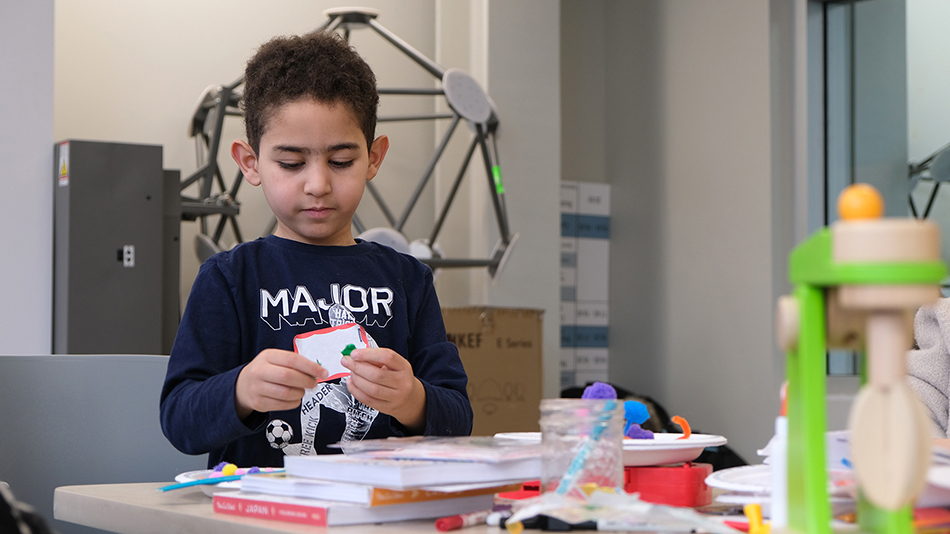Contact Information
Hassam Ansari
Communications Officer, BrainsCAN
Western University
hassam.ansari@uwo.ca
New study makes sense of sensory processing in autistic children
November 15, 2021 - BrainsCAN Communications

A child plays with sensory-based objects during a day camp held in January 2020 by the Sensory Perception Research lab at Western University.
Results of a recent study on sensory abilities in autistic children may have positive consequences to the way supports are provided to them, helping increase their quality of life.
Western University psychology professor, Ryan Stevenson and Western BrainsCAN postdoctoral fellow Nichole Scheerer were part of a study that examined the sensory abilities of 599 autistic children. The results, published last month in Molecular Autism, found that sensory abilities can be grouped into five phenotypes or categories, revealing different sensory processing patterns. These categories were also found to predict autistic behavioural traits.

Ryan Stevenson
Psychology Professor, Western University

Nichole Scheerer
BrainsCAN Postdoctoral Fellow
“We were looking for patterns to see if certain traits tend to co-occur together,” said Scheerer, first author of the study. “If someone tends to be more sensitive to sound, are they also going to be more sensitive to light? If someone is sensitive to textures and tactile stimulation (things like pain and temperature), are they also sensitive to tastes, but not sensitive to light?”
Events people encounter daily involve sensory processing in the brain. These experiences include sight, sound, smell, touch and, in the case of eating, taste and texture. For many, processing this sensory information does not cause distress, but for those with autism spectrum disorder, a neurodevelopmental condition characterized by social, communication and behavioral challenges, their experience can be quite different.
The way autistic people process touch, taste, smell, sound and other sensory information can vary from person to person. These sensory differences make it impossible to create a one-size-fits-all environment that meets the needs of autistic individuals.
The study was conducted to better understand these sensory differences.
The five identified categories of sensory processing in autism were: taste and smell sensitivity; underresponsive and sensation seeking; movement difficulties with low energy; little difficulty in sensory processing; and difficulties in all areas of sensory processing.
By identifying these five combinations of sensory processing patterns, the researchers were able to link the categories with behavioural traits commonly observed in autistic people. These behaviours included socialization difficulties, communication issues, repetition or compulsions, along with clinical traits found in attention deficit hyperactivity disorder and obsessive-compulsive disorder.

“Sensory issues can cascade and impact other cognitive abilities and clinical presentations, things like social communication and repetitive behaviours – two of the defining pieces of autism” said Stevenson, senior author of the study and a core member of Western’s Brain and Mind Institute. “Children with different sensory processing patterns also showed differences in adaptive behaviours and daily living skills. This shows that sensory differences can have a big impact on the day-to-day experiences of autistic children.”
“An autistic child might perform poorly in the classroom, not because they have cognitive difficulties. Rather, because they process sensory information differently than their peers, the sensory environment in their classroom may interfere with their ability to concentrate and perform cognitively,” added Scheerer. “This really highlights that in order to help autistic children and make a difference in their lives, we need to invest in creating sensory-friendly environments and do a better job of accommodating sensory needs.”
With a better understanding of the sensory categories, the researchers hope this work will lead to more awareness of the different sensory experiences of autistic children, along with a more tailored approach to supporting them.
“There is a lot you can do to change the sensory environment for an autistic child,” said Stevenson. “If there’s a child who is sensation-seeking, providing more stimulation or allowing them to stim may reduce some of the behaviours that disrupt the child’s learning. Understanding what drives the different behaviours that cause stress to a child can allow us to provide the supports they need, and increase their quality of life.”
“The more we understand the challenges that autistic children experience, the better we can be in terms of creating environments that accommodate them,” added Scheerer.
This study was conducted in conjunction with the Province of Ontario Neurodevelopmental Disorders (POND) Network.







